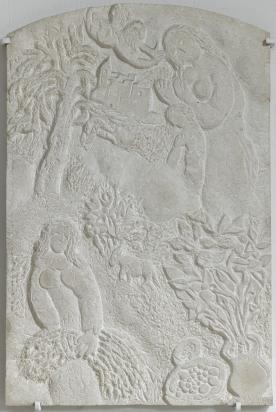Two low-reliefs in marble, grouped under the shared title Women of the Bible, with identical shapes and dimensions, make up a diptych initially destined for an architectural project. This is evidenced by a specific, underslung arch form evoking antique stelae, as well as two preparatory drawings in pencil and India ink. The drawings, presenting the same iconographic design and composition as the marble sculptures, nevertheless reveal a change in intention. Both mockups, in the shape of semicircular arches, feature an empty space in the middle, seemingly made to allow for the placement of a window. The initial project they were intended for remains a mystery, and Chagall transposed, as he often did, the two compositions to another surface.
His decision to use low-relief was significant for the artist, as it evokes the bidimensionality of painting and harks back to the etching technique that Chagall had experimented with in the 1920s. He created a series of engravings illustrating Bible stories, begun in 1931 at the behest of Ambroise Vollard and published in 1956 by Tériade, using acid etching often in combination with drypoint and aquatint. The monochrome prints made from etched copper plates, occasionally colored with gouache, are fascinating in terms of the flexibility, depth of volume, precision, and the vibration of the lines engraved. This etching technique and its graphic appearance echo the carving of low-reliefs in marble, here exhibiting the “raw” aspect of carving in marble. On the surface of this luminous, easily workable stone, one can see burin marks and the rhythmic movement of the gradine, left as-is, unpolished. Deep etchings, combined with lighter strikes, form human shapes and create vibrating effects in the landscape and vegetation.
Penciled captions on the drawings identify the four women, whose lives are recounted in the Old Testament. Sarah is visited by an angel announcing the birth of Isaac, shown near the mother’s body. Rebecca, wife of Isaac and mother of Jacob, carries a large flower arrangement in her arms. Rachel, her daughter-in-law, the dearly loved wife of Jacob, is lying down and appears to be floating in the air above a building with a cupola, evoking the architecture of her tomb, which Chagall visited in 1931 on a trip to Palestine. Lastly, Leah, Rachel’s older sister and the first wife of Jacob, carries a vase filled with water. Such freedom in the iconographic interpretation of Bible women, some of whom are deprived of their usual features, undoubtedly attests to an eagerness to move past codes and emancipate the characters from them. Often reduced in religious texts to their role as mothers, the matriarchal women are considered, in the so-called Abrahamic religions—Judaism, Christianity, and Islam—as the forebears of “a multitude of nations.”
